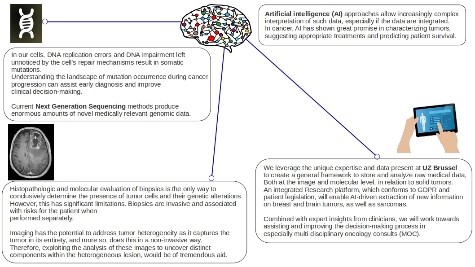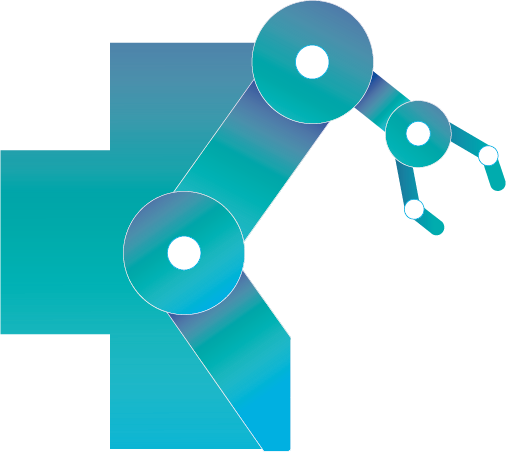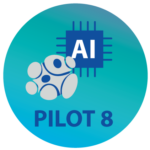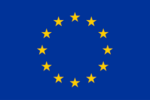Improving cancer patient diagnosis and treatment response with AI
Description
Prognosis of cancer patients and their response to treatment combining multiomics data.
Domain
Diagnosis and Treatment Improvement
Leader
UZ Brussel (Brussels)
Background
The availability of advanced diagnostic tests and emergence of personalised medicine have made oncological care increasingly complex and data dependent. Medical imaging has become an integral part of the care process; it is used extensively for diagnosis, treatment planning and during follow-up. The rapid technological progress in Next Generation Sequencing is enabling the collection of novel medically relevant data at the molecular level. We need to unlock the genetic and image data and make this data available for research to develop more automated tools for personalised treatment of the patients.
Problems
We focus on Glioma, Accurate glioma diagnosis is based on two major elements, namely segmentation of the tumour and tumour infiltration and characterisation, including the determination of the subtype, grade and the relevant mutations contributing to tumour development. Currently, image and genetic data for glioma are analysed separately to determine the most effective treatment for a patient while their combined use would improve the diagnosis. Furthermore:
- while automated segmentation of brain tumours is well covered, regions of infiltration – which are important for recurrence – are often overlooked
- availability of data on mutations is significant, but they are more a global label from one biopsy over the whole tumor while mutations can differ spatially throughout the tumours
- from a genetic point of view, there are predictors that can classify a mutation as pathogenic but frequently the interpretation supporting physicians’ decision-making is missing
- researchers need to have access to data to advance the work on these tumours. The data needs to be integrated to provide more personalised treatment.
Objectives
Connect researchers with clinicians via an AI-based platform which will improve glioma diagnosis by enabling
- storage and analysis of pseudonymized medical data – both at image and genetic level – their clinical behaviour and response to therapies
- modelling the infiltration in segmentations of tumor images
- localizing different mutations which could potentially contribute to the heterogeneity of cancer that are sometimes overlooked in both research and in other predictors (spatial mapping of tumour heterogeneity)
- providing interpretation of the prediction

The solution
A general AI-based framework to store and analyze raw medical data, both at image and molecular (genetic) level, in relation to brain tumours, their clinical behaviour and response to therapies. The platform will leverage two tools: 1) the first is an algorithm that aims at interpreting a single mutation and is currently being trained on public available data (providing very good results); 2) the second is a segmentation tool that models the different regions of the tumour based on intensity distributions and is being extended to include regions of infiltration. These tools will be integrated in one unique platform to fully exploit their combined potential, provide an integrated view on patients’ data for research, enable AI-driven extraction of new information on such tumours, highlighting features or relationships in the data that may have been missed, but that could be taken into consideration by clinicians in their diagnosis. This will be achieved in full conformity with GDPR and patient safety legislation.
Value Proposition
There is an enormous amount of genetic and image data produced related to tumors, and the time has come to use the data and make it available, for research to develop AI based tools, to interpret the hidden information about the diseases.
Main solution provider:
VUB – Contact: Wim Vranken, wim.vranken@vub.be; Nivedita Yadav, nivedita.yadav@vub.be
Jef Vandemeulebroucke,jef.vandemeulebroucke@vub.be
Hosting Facility:
UZ Brussels







